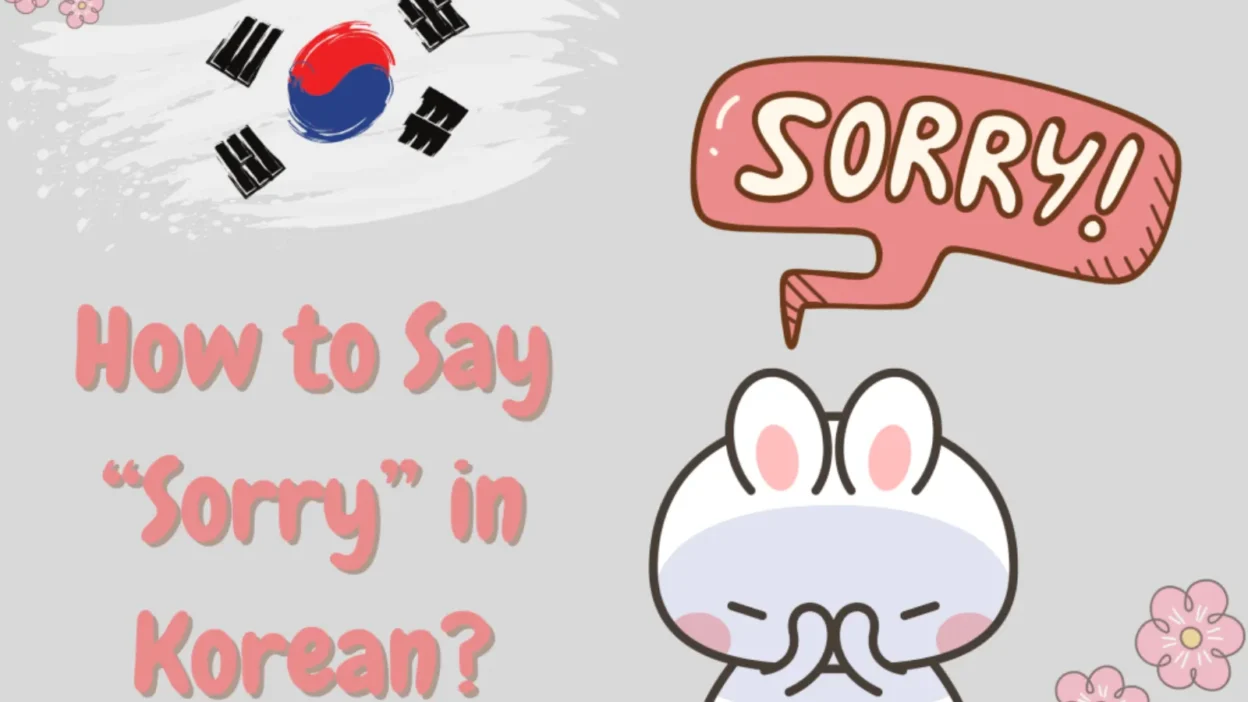How to Say Sorry in Korean is an essential phrase to learn if you’re trying to speak the language respectfully and build strong relationships. In Korean culture, showing sincerity and humility through apologies is highly valued. If you’re in a formal setting or talking to friends, knowing the right way to say sorry can make a big difference.
From casual apologies to deeply respectful expressions, this guide will help you understand how to say sorry in Korean the right way.
Learning how to say sorry in Korean also helps you avoid misunderstandings and show cultural awareness. It’s a small phrase that can leave a powerful impact in any interaction.
Say Sorry in Korean Examples & Origin
Here are 15 authentic ways to say sorry in Korean—with sample conversations, cultural background, and when to use each one.
15 phrases for How to Say Sorry in Korean
| # | Korean Phrase | Romanization | English Meaning | Example Sentence (Korean) | Example Sentence (English) |
|---|---|---|---|---|---|
| 1 | 미안해 | mianhae | Sorry (casual) | 늦어서 미안해. | Sorry for being late. |
| 2 | 미안합니다 | mianhamnida | Sorry (formal) | 실수해서 미안합니다. | I’m sorry for the mistake. |
| 3 | 죄송해요 | joesonghaeyo | I’m sorry (polite) | 방해해서 죄송해요. | Sorry for disturbing you. |
| 4 | 죄송합니다 | joesonghamnida | I apologize (very formal) | 늦어서 죄송합니다. | I apologize for being late. |
| 5 | 미안 | mian | Sorry (very casual/short) | 미안, 깜빡했어. | Sorry, I forgot. |
| 6 | 정말 미안해 | jeongmal mianhae | I’m really sorry | 정말 미안해, 의도한 게 아니야. | I’m really sorry, I didn’t mean it. |
| 7 | 진심으로 사과드립니다 | jinsimeuro sagwa deurimnida | I sincerely apologize (formal) | 불편을 드려 진심으로 사과드립니다. | I sincerely apologize for the inconvenience. |
| 8 | 용서해 줘 | yongseohae jwo | Forgive me (casual) | 제발 용서해 줘. | Please forgive me. |
| 9 | 용서해주세요 | yongseohae juseyo | Please forgive me (polite) | 실수를 용서해주세요. | Please forgive my mistake. |
| 10 | 잘못했어 | jalmothaesseo | I was wrong (casual) | 내가 잘못했어. | I was wrong. |
| 11 | 잘못했습니다 | jalmothaetseumnida | I was wrong (formal) | 제가 잘못했습니다. | I was wrong (formal apology). |
| 12 | 미안 미안 | mian mian | Sorry, sorry (cute/slang) | 미안 미안, 장난이야. | Sorry sorry, it’s just a joke. |
| 13 | 미안하다 | mianhada | To be sorry (neutral form) | 내가 너에게 미안하다. | I am sorry to you. |
| 14 | 실례합니다 | sillyehamnida | Excuse me / Sorry (formal, polite interruption) | 실례합니다, 잠시만요. | Sorry, excuse me a moment. |
| 15 | 송구합니다 | songguhamnida | Deep apology (very formal, humble) | 늦게 와서 송구합니다. | I deeply apologize for being late. |
1. 죄송합니다 (joesonghamnida) — I’m sorry (formal)
Origin/Context:
This is the most formal way to apologize. Common in customer service, public settings, and workplace situations where politeness is essential.
Example:
👤 User A: 죄송합니다. 제가 늦었어요.
👤 User B: 괜찮아요. 다음부터는 조심하세요.
(I’m sorry. I’m late. / It’s okay. Be careful next time.)
Use: Formal; to elders, strangers, superiors.
2. 미안합니다 (mianhamnida) — I’m sorry (less formal than 죄송합니다)

Origin/Context:
Still respectful but slightly softer than 죄송합니다. Suitable in polite company but not as stiff or public-facing.
Example:
👤 User A: 미안합니다. 방해했나요?
👤 User B: 아니요, 괜찮아요.
(Sorry, did I interrupt? / No, it’s fine.)
Use: Polite; good for general situations.
3. 미안해요 (mianhaeyo) — I’m sorry (polite, everyday)
Origin/Context:
This polite version of 미안해 is used among acquaintances, co-workers, or older friends when you still want to be respectful.
Example:
👤 User A: 미안해요. 너무 늦었네요.
👤 User B: 조금 늦었지만 괜찮아요.
(Sorry, I’m really late. / You’re a bit late, but it’s okay.)
Use: Polite but more casual than -hamnida versions.
4. 미안해 (mianhae) — Sorry (informal)
Origin/Context:
Used with close friends, siblings, or younger people. It shows sincerity but in a relaxed way.
Example:
👤 User A: 미안해, 네 컵 깼어.
👤 User B: 괜찮아. 그냥 컵이잖아.
(Sorry, I broke your cup. / It’s okay. It’s just a cup.)
Use: Informal; only with people close to you.
5. 정말 미안해 (jeongmal mianhae) — I’m really sorry
Origin/Context:
Adds emphasis. “정말” means “really,” showing deeper regret or urgency.
Example:
👤 User A: 정말 미안해. 너한테 너무 심했어.
👤 User B: 이제 알았으면 됐어.
(I’m really sorry. I was too harsh on you. / It’s okay now that you understand.)
Use: Informal, heartfelt apologies.
6. 진심으로 사과드립니다 (jinsimeuro sagwadeurimnida) — I sincerely apologize (very formal)

Origin/Context:
Extremely formal; often used in speeches, press conferences, or public statements.
Example:
👤 User A: 진심으로 사과드립니다. 저의 실수였습니다.
👤 User B: 사과를 받아들이겠습니다.
(I sincerely apologize. It was my fault. / I accept your apology.)
Use: Very formal, public or written apologies.
7. 실례합니다 (sillyehamnida) — Excuse me / Pardon me
Origin/Context:
Used more to get someone’s attention or excuse yourself, not a direct apology—but functions as one in some contexts.
Example:
👤 User A: 실례합니다. 지나가도 될까요?
👤 User B: 네, 물론이죠.
(Excuse me. Can I pass through? / Yes, of course.)
Use: Formal; polite interruptions or minor offenses.
8. 용서해 주세요 (yongseohae juseyo) — Please forgive me
Origin/Context:
Emotional and slightly dramatic. Often used when you seek deep forgiveness for a mistake.
Example:
👤 User A: 정말 미안해요. 용서해 주세요.
👤 User B: 아직 힘들지만 생각해볼게요.
(I’m really sorry. Please forgive me. / It’s still hard, but I’ll think about it.)
Use: Emotional or serious personal matters.
9. 내 잘못이야 (nae jalmotiya) — It’s my fault
Origin/Context:
Shows responsibility and ownership. Often paired with other apologies.
Example:
👤 User A: 내 잘못이야. 모두 내 탓이야.
👤 User B: 인정해줘서 고마워.
(It’s my fault. All my fault. / Thanks for admitting it.)
Use: Casual to emotional confessions.
10. 내가 실수했어 (naega silsuhaesseo) — I made a mistake

Origin/Context:
Very direct and honest. Admitting a mistake openly is valued in Korean relationships.
Example:
👤 User A: 내가 실수했어. 다시는 안 그럴게.
👤 User B: 알겠어. 조심해.
(I made a mistake. I won’t do it again. / Okay. Be careful.)
Use: Informal; sincere personal apologies.
11. 잘못했습니다 (jalmothaetseumnida) — I was wrong (formal)
Origin/Context:
A very formal version of admitting wrongdoing. Used in serious settings, often military or official situations.
Example:
👤 User A: 잘못했습니다. 다시는 반복하지 않겠습니다.
👤 User B: 반성하는 태도 보기 좋네요.
(I was wrong. I won’t repeat it again. / Glad to see you reflecting on it.)
Use: Formal confessions; respectful settings.
12. 괜찮아요? (gwaenchanayo?) — Are you okay?
Origin/Context:
Not technically “sorry,” but used to check on someone after you may have hurt or bumped into them.
Example:
👤 User A: 아! 죄송해요. 괜찮아요?
👤 User B: 네, 괜찮아요.
(Oh! I’m sorry. Are you okay? / Yes, I’m fine.)
Use: Polite; everyday accidents.
13. 사과할게요 (sagwahalkkeyo) — I will apologize
Origin/Context:
Future tense; implies intention to apologize. Shows awareness and readiness to make amends.
Example:
👤 User A: 그 사람한테 사과할게요.
👤 User B: 잘 생각했어요.
(I’ll apologize to them. / That’s a good idea.)
Use: Polite; showing intent to fix a wrong.
14. 그럴 뜻은 아니었어요 (geureol tteuseun anieosseoyo) — I didn’t mean that
Origin/Context:
Softens the situation when a misunderstanding happens. Often used to clarify accidental offense.
Example:
👤 User A: 그런 뜻은 아니었어요. 미안해요.
👤 User B: 알았어요. 오해였군요.
(I didn’t mean it that way. Sorry. / Got it. Just a misunderstanding.)
Use: When emotions or intentions are misinterpreted.
15. 그냥 무시해줘 (geunyang musihaejwo) — Just ignore it / Forget it
Origin/Context:
Used after a small mistake or awkward moment when you don’t want someone to feel uncomfortable.
Example:
👤 User A: 아, 창피해! 그냥 무시해줘.
👤 User B: 하하, 알겠어.
(Ah, how embarrassing! Just ignore it. / Haha, okay.)
Use: Informal; light mistakes or social blunders.
FAQs
1. What is the most common way to say sorry in Korean?
The most common phrase is 죄송합니다 (joesonghamnida), used in formal situations.
2. How do you say sorry informally?
Say 미안해 (mianhae) when talking to friends or people younger than you.
3. How do you pronounce “죄송합니다”?
It is pronounced: joe-song-ham-ni-da.
4. How do you pronounce “미안해”?
It is pronounced: mee-ahn-hae.
5. When should I use 죄송합니다 instead of 미안해?
Use 죄송합니다 in formal, professional, or polite situations, like at work or with elders.
6. Can I just say “sorry” in English in Korea?
Yes, but Koreans appreciate the effort to use Korean phrases.
7. How do I apologize for a mistake politely?
Say 정말 죄송합니다 (jeongmal joesonghamnida) — “I am really sorry.”
8. How do I apologize casually to a friend?
Say 정말 미안해 (jeongmal mianhae) — “I am really sorry” in informal situations.
9. Is there a slang way to apologize among youth?
Some may say 쏘리 (ssori) — a Koreanized pronunciation of “sorry,” very casual.
10. How do I say “Excuse me / Sorry” when bumping into someone?
Say 죄송합니다 (joesonghamnida) or 실례합니다 (sillyehamnida) for “Excuse me.”
Conclusion:
Now that you’ve learned how to say sorry in Korean, you’re better prepared to communicate with respect and sincerity. Whether it’s a simple “미안해” (mianhae) or a formal “죄송합니다” (joesonghamnida), using the right apology can strengthen your relationships and show genuine understanding of Korean culture.
Practice regularly, and soon saying sorry in Korean will come naturally in any situation.



